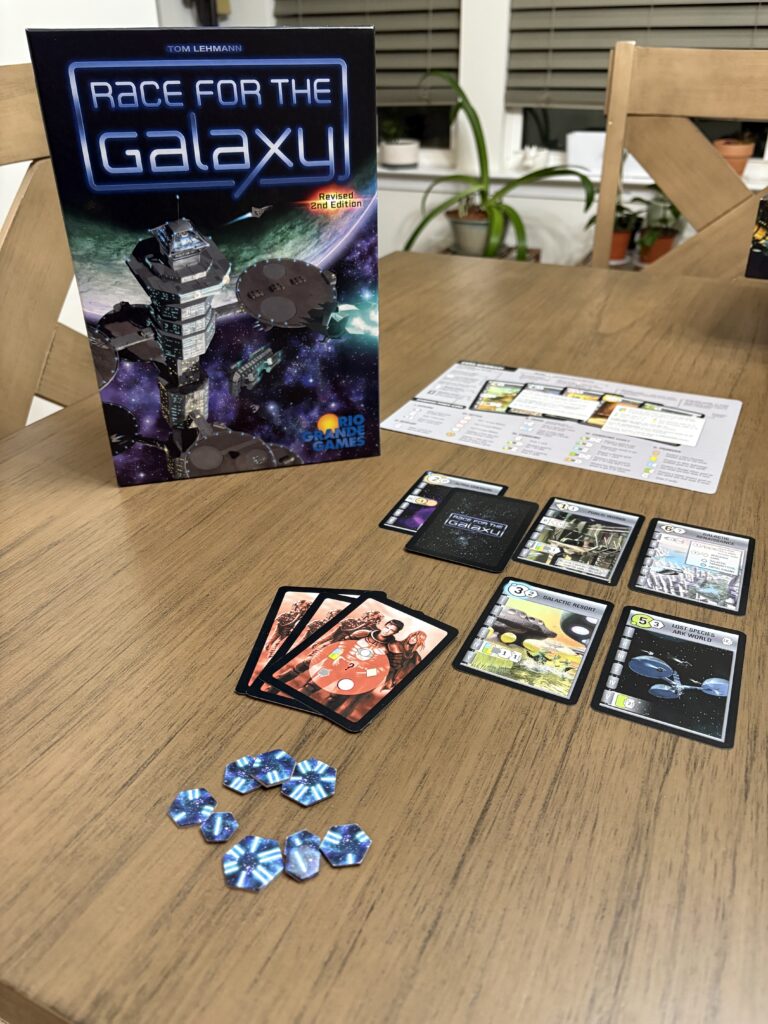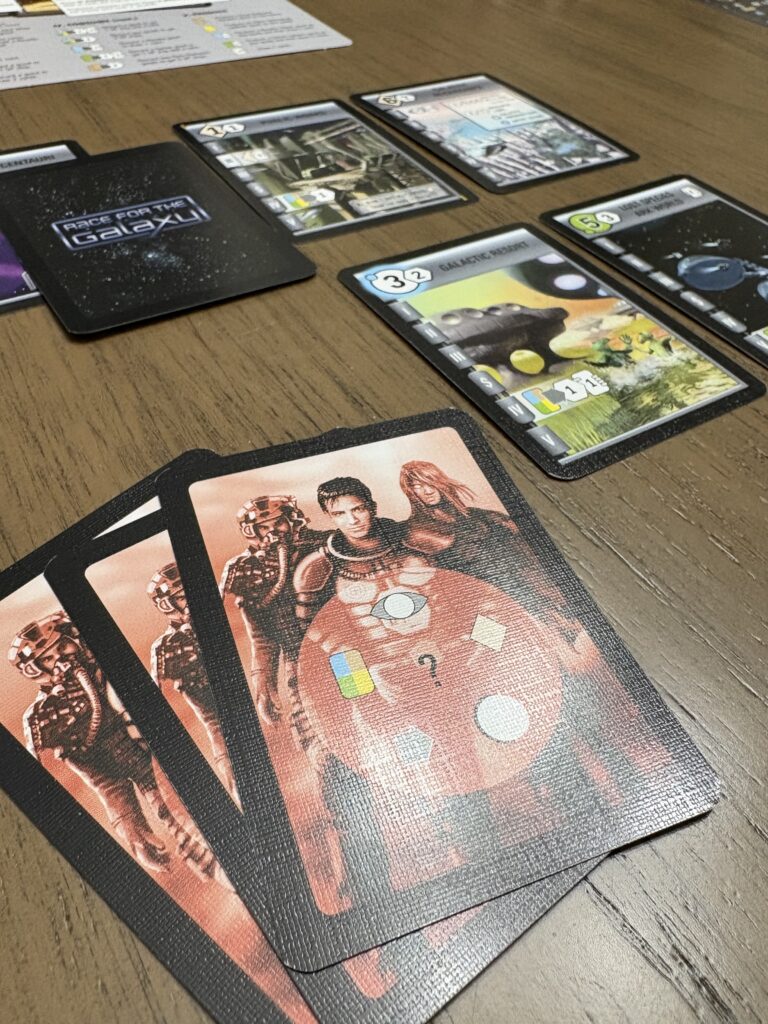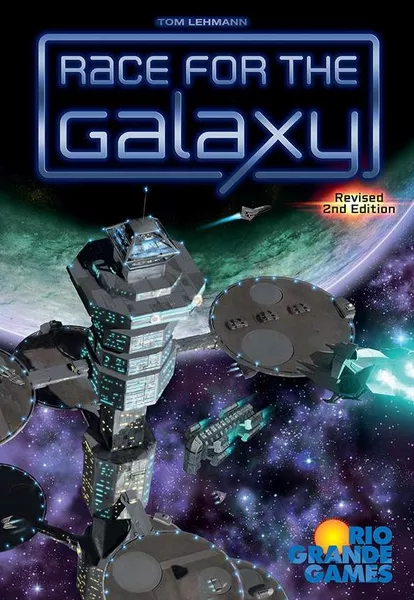Welcome to this week’s review! This week I’m discussing a game that was originally released in 2007, and you can check out an unboxing of the revised second edition here. So without further ado, let’s jump into my thoughts.
Disclosure: A review copy of this game was provided to The Meeple Digest in exchange for an honest, unbiased review. This review is not intended to be an endorsement.
Race for the Galaxy
- Designer: Thomas Lehmann
- Publisher: Rio Grande Games
- Complexity: Medium
- Time: 30-60 Minutes
- Players: 2-4
- Main Mechanisms: Simultaneous Action Selection, Tableau Building
Race for the Galaxy is one of the original engine-building, card tableau games. Each round, players simultaneously and secretly select an action card from one of five different types of actions. After each player chooses a card, all players reveal and everyone is able to perform each of the actions chosen. In addition, the player who plays the action card receives a bonus for that action.

This follow-the-leader system where one person selects an action and then all players get to perform that action is a mechanism that has been used in plenty of games. One of the earliest games that comes to mind is Puerto Rico. More recently, the mechanism was heavily borrowed in Terraforming Mars: Ares Expedition. What’s interesting about this mechanism is that it forces players to consider what others are doing. For example, I might really want to perform the settle action, but I also want to perform the consume action. If another player at the table has started to build an engine that encourages settling new worlds, then odds are they are likely to play the settle action this round, and therefore, I could play the consume action and still get to perform both actions. Overall, I really enjoy this follow-the-leader mechanism because it allows for player interaction without directly impacting another player’s tableau.
The actions themselves are also fairly straightforward. The five actions are: draw cards from a central deck, play a development card (cards with a diamond symbol) from your hand, play a world card (cards with a circle symbol) from your hand, produce goods on worlds, or consume goods for victory points using consume actions on cards in your tableau. This allows for the complexity of the game to come from the decision-making and cards themselves rather than a high rules overhead, and it makes the game fairly easy to teach and jump into.
In addition, while there are only a handful of actions, the game still offers plenty of different paths to victory. For example, in a couple games, I focused on building up my military strength and using it to conquer a bunch of worlds. Normally when settling worlds, you have to discard cards from your hand equal to its cost, but for military worlds, you just need to have enough military strength from the cards in your tableau in order to play the military world. Therefore, in that game, I was able to settle a bunch of high value worlds without needing to draw and spend a bunch of cards to do so. In contrast, in a separate play I focused heavily on production worlds and combined them with consume actions that spent goods from the production worlds to gain points. Since most of the cards in the deck are unique, the game offers plenty of different paths to victory and allows each play to feel unique.
I should also mention that along with a fairly straightforward ruleset, the game has almost no setup and wraps up fairly quickly. With two experienced players, we were able to get games finished in around 30 minutes making it a nice option as a fairly quick filler between heavier games.
Finally, the game also comes with individual player aid/summary sheets that explain the round structure, each of the actions, and a card summary with details on the standard icons. I think you could probably hand one of these to a new player and they would have almost all of the information they would need to know to play the game.
Outside of the player aids, the only other components besides the rulebook are the main deck of cards and some victory point tokens. I will say, the art in Race isn’t going to win any awards when compared to newer titles, but it’s all about leveling expectations considering how the game is almost 20 years old.
While we’re on the subject of rules, the most challenging aspect of the game is understanding the iconography. While most of it is self-explanatory, understanding the difference between a windfall world, a production world, and a military world can be a little confusing for new players. As I mentioned, the player aid does a good job of explaining most of the iconography and the non-standard icons are explained on the individual cards themselves. However, I did have one situation where I had to look up one of the 6-cost development powers to understand exactly what it was referring to. As players have more experience with the game, the icons do become clearer, but the game does have a learning curve for what overall is a fairly easy game to teach.

The only real downside of the game for me is that I found that games ended just before players were able to fully realize their engines. As I gained more experience with the game, rather than attempting to build a large engine, I focused more on building out enough of one that would allow me to end the game earlier while still getting enough points to beat my opponent. It’s also probably not a coincidence that our scores also dropped with more plays as we found ways to end the game faster with a smaller, more efficient engine.
Speaking of building an engine, when comparing Race for the Galaxy with other tableau, engine builders, since games of Race end a little earlier than you might initially expect, I didn’t get quite the same joy of seeing an engine fully come together. For example, Wingspan and Earth are other tableau games that I really enjoy, but in those you often get to run your engine a bit more. However, the tradeoff there is that both those games have additional mechanisms and run longer. Where Race for the Galaxy shines compared to those other games comes down to its ability to execute what it sets out to very well. Race for the Galaxy doesn’t layer on additional mechanisms, and that allows it to feel streamlined and maintain its short setup and runtime. Do I come out feeling as satisfied as when I play Wingspan or Earth? Probably not, but I have to give the game credit for sticking to what it does very well.
I should also quickly compare the game to its newer sibling – Roll for the Galaxy. Roll has actually been in my collection for some time now after playing it during a small convention many years ago and instantly getting hooked. Roll shares plenty of the same DNA as the original, but uses dice instead of cards when carrying out actions. Is there room for both in the collection? Yes. At this point, I don’t know that I strongly prefer one over the other, but personally, I’ll likely opt to play Roll with three or four players and use Race when only playing at two.
So going back to the original question posed at the beginning of this review, does Race for the Galaxy still hold up after almost 20 years? Absolutely. While the follow-the-leader mechanism has been used in other games, and there are tons of card, tableau, engine-building games out there today, Race still executes on its original idea very well. Are there other engine-building games that I prefer? Sure, but that won’t stop me from still turning to Race for the Galaxy when I’m looking for an interesting, two-player filler.
With that, I’ll wrap up this week’s review! I’d love to hear your thoughts on any of the games I’ve mentioned or future content suggestions in the comments below. Happy gaming!
If you liked this post and want to be notified when new content is released, then follow me on Instagram @themeepledigest.
